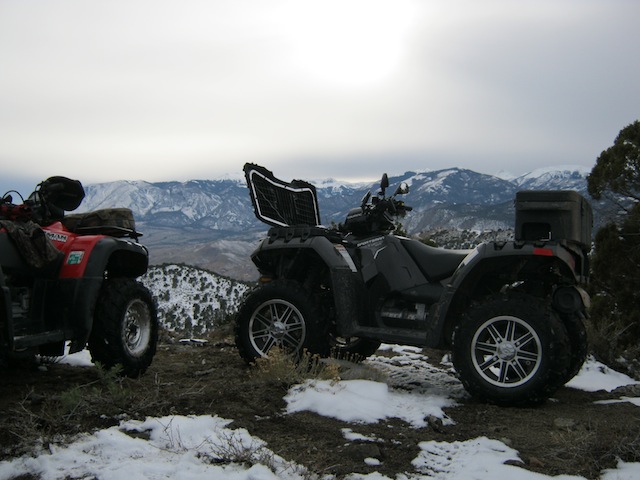Come the end of September, most folks park their ATV in the garage under the boxes of christmas lights and ornaments, and curl up on the couch and watch past episodes of 24, the NFL, or (hopefully!) sit with their computer on their laps and read about ATVs!
Well let me tell you, just because the temperature drops and there's some snow on the ground doesn't mean you have to stop riding!
While much of the higher elevation trails are now covered with snow that's deep enough to keep you from comfortably exploring them, and others with many downed trees blocking the trail, there are still many, many miles of trails that are waiting to be enjoyed.
While I'm not a big fan of riding in the mud, there is unfortunately some to be found on the trails between the elevations of damp dirt and snow. But not all that much, and if you are one of those folks that know about the advantages of keeping your tires within the confines of the fenders of your machine it's not all that much of a problem ;-)
So right now there are still way more miles of trails than you have the time to ride, open and ready to be discovered. And I say 'discovered' because with a little bit of snow, every trail takes on a whole new character. There is nothing better than putting the first set of tracks on a trail. And every trail looks like a new one when there's snow on them. Plus, they take on a whole new feel - they are both smoother and more challenging.
Oh, and travel with a friend, because chances are you won't see another rider all day!
It's awesome! Maybe I'll see you out there.......
Information on each event is available on the Internet. The following is a list planned for 2010 in order of their occurrence:
The Rally on the Rocks, May 12-15: The fourth annual Rally on the Rocks is the premier UTV event is held in Moab, Utah. MORE INFO
The National ATV Jamboree, June 21-26: The oldest jamboree in the nation is held in Fillmore. The $130 fee includes a hot breakfasts and dinners every day, maps and a jamboree T-shirt. Trails on the Paiute ATV Trail system are featured as well as some desert destinations. Registration is limited to 500 riders and discounts are available to couples and groups. MORE INFO
The National ATV Jamboree, June 21-26: The oldest jamboree in the nation is held in Fillmore. The $130 fee includes a hot breakfasts and dinners every day, maps and a jamboree T-shirt. Trails on the Paiute ATV Trail system are featured as well as some desert destinations. Registration is limited to 500 riders and discounts are available to couples and groups. MORE INFO
The Paiute UTV Jamboree, Aug. 12-14: The second annual Marysvale jamboree primarily for UTVs is staged in Marysvale. A unique feature of this event is that no registration fees are charged. You can choose to order a shirt and meals, or not. MORE INFO
The Manti Mountain ATV Tour, Aug. 13-14: This event includes a T-shirt, dinner, two lunches, and two days of riding on the Arapeen trails above Manti for $50. MORE INFO
The Arapeen ATV Jamboree, Sept. 6-10: This event featuring trails in the San Rafael Swell and on the east side of the Arapeen Trail system is staged from Ferron. The $120 fee includes continental breakfasts each day, two dinners and a T-shirt. Two additional dinners are available at $10 each. MORE INFO
The San Juan ATV Safari, Sept. 16-18: Blanding is the host for this festival featuring trails in the Blue Mountains and surrounding canyons. Fees are $100 per rider with special rates for groups. MORE INFO
The Rocky Mountain ATV Jamboree, Sept. 20-24: The largest ATV festival is sponsored by Richfield. Registration is $150 per rider and is limited to 650 participants. Fees include daily continental breakfasts, two dinners and a T-shirt. This jamboree features trails in the Paiute trail system and others in Central Utah. MORE INFO






















































